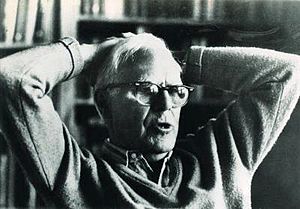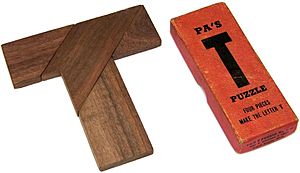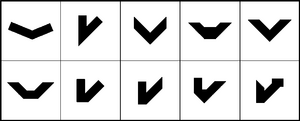T puzzle facts for kids
The T puzzle is a tiling puzzle consisting of four polygonal shapes which can be put together to form a capital T. The four pieces are usually one isosceles right triangle, two right trapezoids and an irregular shaped pentagon. Despite its apparent simplicity, it is a surprisingly hard puzzle of which the crux is the positioning of the irregular shaped piece. The earliest T puzzles date from around 1900 and were distributed as promotional giveaways. From the 1920s wooden specimen were produced and made available commercially. Most T puzzles come with a leaflet with additional figures to be constructed. Which shapes can be formed depends on the relative proportions of the different pieces.
Commercial puzzle
Just the T
The T puzzle remained popular throughout the 20th century and versions of it were sold as a game puzzle as early as the 1920s'. An example dated around that time is a French version of the puzzle called "L'ÉTÉ" produced by N.K. Atlas of Paris. Another example is the wooden version of the puzzle produced by Drueke & Sons, under the name "Pa's T puzzle", dated around the 1940s and here depicted to the right. Later also versions were produced with plastic pieces, such as "Adams T puzzle" by S.S. Adams Co in the 1950s' and "The famous T puzzle" by Marx Toys in the 1960s-1970s. From the 1980s' dates the "Mr T's puzzle" featuring the actor Mr. T from the popular A-Team TV series; the back of the product packaging has the catchphrase "I pity the fool who can't solve Mr. T's puzzle".
Extensions
It was recognized early on that other shapes could be formed with the four pieces of the T puzzle, similar to the tangram. From the 1930 dates an advertising premium for Mohawk Rugs & Carpets which besides the regular T, features the challenge of making an arrowhead with the same pieces. In the same year a giveaway for Eberhard Faber's Van Dyke pencils featured 14 different shapes to form.
At present T puzzles come in standardized proportions which allow the construction of many additional shapes. The most important designs are (see also figure below):
- Nob's T puzzle: Designed by Nob Yoshigahara, this version of the T puzzle sold over four million copies. The pieces can be laid out in the shape of a symmetrical convex pentagon with two right angles.
- Asymmetric T: This T is asymmetric in that the left and right arm of the T have different lengths, with the shorter arm being about 83% of the longer one. Here all pieces have the same width and can be put in a perfect line segment. At present this puzzle is for instance sold by HIQU and comes with 100 figures to make and by Eureka Toys and Games in a puzzle called brain twister.
- Gardner's T: This is the version featured in Martin Gardner's Scientific American column. The pieces also form a fatter T, as noted in a later column. This version was sold under the name "The missing T" as part of Aha! Brain teasers classics from Think Fun.
Solving the puzzle

With only four pieces, the T puzzle is deceitfully simple. Studies have shown that few people are able solve it under five minutes, with most people needing more than half an hour to solve it. A common response of subjects is to conclude that the puzzle is impossible to solve.
The main difficulty in solving the puzzle is overcoming the functional fixedness of putting the pentagon piece either horizontally or vertically; and related to this, the tendency of trying to fill up the notch of the pentagon. In one study participants were found to spend over 60% of their attempts on such misguided placements of the pentagon piece. And even when the pentagon piece happened to be placed properly, it was mostly not recognized as part of the solution, as a match with the T is not easily seen. The puzzle is easily solved when the insight is reached that the pentagon is part of both the horizontal and vertical stem of the T and that the notch in the pentagon constitutes an inside corner.
See also
 In Spanish: Rompecabezas T para niños
In Spanish: Rompecabezas T para niños





